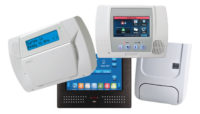We only install IP,” keynote Domenic Flores, senior project manager for Royal Caribbean Cruise LTD, Miami, bluntly said while discussing the cruise lines’ security philosophy at the Axis A&E Technology Summit 2011. Flores’ presentation illustrated one simple message from Axis Communications Inc., Chelmsford, Mass., and its technology partners during the summit — IP adoption continues to move full steam ahead with stronger business value and a rapidly falling price tag that matches the added features and functionality IP-based systems offer.
Flores has participated in 18 newbuild, seven retrofit, and 45 drydocks, and managed a fleetwide CCTV upgrade project of 14,000 cameras across 32 ships. Any analog cameras on Royal Caribbean’s ships (there are still about 6,000 to 7,000) are from original builds. The CCTV systems on the ships are not for active surveillance, rather they are “post event driven, designed to protect guests and employees from false accusations of wrong doing,” Flores describes.
Not only did the architects and engineers (A&Es) attending the event have a chance to hear from Flores about Royal Caribbean’s security philosophies, they got to experience them first hand, as the A&E Technology Summit 2011 begin at the Rosen Shingle Creek Resort in Orlando, and then took to the high seas, for a three-day cruise to the Bahamas aboard the Royal Caribbean’s Monarch of the Seas vessel.
In addition to Flores, attendees heard from the representatives of 14 Axis technology partners that participated in two technology panels and held an Axis partner exhibition and solution display to complement all the information being shared at the summit’s workshops (some of which were eligible for ASIS credits) and general sessions led by Axis staff. The Axis ecosystem partner participants interacting with the A&Es throughout the event included Allied Telesis, CommScope, Firetide, Iomega Corporation, Veracity, Video Insight, Salient Systems, OnSSI, NICE, Aimetis Corp., Exacq, Genetec, and Milestone.
For the last four years, Axis has hosted the members of its A&E program at an annual technology summit. This year, nearly 100 A&Es attended the event.
While on the cruise, attendees watched Super Bowl XLV on the ship in the glass-enclosed Viking Crown Lounge that was filled with high definition (HD) flat screens. It seemed only fitting. Axis Communications is highly invested in bringing HD from the consumer world into security — and according to IMS Research’s latest report, “The World Market for CCTV and Video Surveillance Equipment — 2010 Edition,” by 2014 more than 50 percent of all network cameras shipped will be HD or megapixel resolution. That makes the growth of HD video surveillance equipment one of the key trends shaping the video surveillance market. At the summit, the A&Es tapped HD as generally having more application possibilities than megapixel although it still “doesn’t have enough applications to make it a one-size-fits-all technology.” They also indicated they’d like to see a standard for image quality and prefer matching the HD technology in monitors and TVs to HD technology in the cameras providing the content.
A&Es are specifying analytics, with direction, trip wire, and people counting leading the list. But accuracy remains a top concern. “Customers expect 100 percent accuracy and anything less than that devalues the system. For some applications, anything less than 100 percent becomes a very public and a very expensive issue. Take an airport using analytics at exit lanes. Anything less than 100 percent starts to devalue the camera and advocates having that person sitting there in the exit lane,” one attendee pointed out.
Accuracy concerns aside, the A&Es did acknowledge a growing awareness of analytics in end users, echoing a series of surveys Axis conducted in the United States and in Europe that found there is widespread awareness of the various applications available for network video surveillance. The most known are people counting and queue counting with an average of 67 percent of respondents across the United States and Europe who have heard of these. Retailers are not only aware of applications but there is a high willingness among them to use these technologies in the future.
Standards and certifications are the mandatory wave of the future. They both came up in multiple sessions and in many conversations. More A&Es are stressing that they won’t just specify the product anymore — they also will specify the certifications and professional designations an integrator needs to have to be eligible for the job. Also, they’re asking that companies no longer be certified, but the individuals actually performing the jobs be certified instead.
A&Es indicated an interest in the new Axis Certification Program, launched in January 2011, which provides security professionals with a third-party validation of their competence and skills in the area of IP video surveillance.
Fredrik Nilsson, general manager, Axis Communications, says, “As the scales tip from analog to IP technology, the Axis Certified Professional stamp will be a sought after designation that proves you have the know-how to install and maintain a proper network surveillance system.”
When a participant passes the advanced Axis Network Video Exam, it proves they are well-versed in the latest network video technologies, solutions, Axis products and best-practice techniques.
For more details about the Axis Certification Program, visit www.axis.com/certification.
“Having a professional designation is good because I can write it into the design specification and ensure that the job will be completed the way I actually wrote the specification,” one attendee commented. “Plus, because companies can have multiple employees at multiple skill levels, I don’t want a certification for the company, I want a certification for the actual guy who will be working on my project.”
The Axis A&E Technology Summit 2011 touched on many current and upcoming trends and explored changes in the video surveillance industry, providing its attendees the opportunity to both listen to and participate in the conversation.
“It was terrific to see how much interest there is in security applications from the architects and engineers, especially the IT architects. We were very excited to educate them on how powerful and cost effective IP video surveillance has become,” said Rob Shaw, chief executive officer, Video Insight Inc., Houston.
Gadi Piran, co-founder, president and chief technical officer of On-Net Surveillance Systems, Inc. (OnSSI), Pearl River, N.Y., adds, “It is extremely important for us to be here to show A&Es that we are integrating and building systems that operate together and provide complete IP systems. At trade shows there is so much going on to the point it can become confusing. But here it is a single focus all about the technology. The partners here today are moving in one direction as one because we all have the same mission to bring sensible technology that works and lets the industry provide end users with the right solutions. IP has major traction.”
It is moving forward full steam ahead.
The Axis (Architect and Engineer) A&E program is open to qualified independent network architects, engineers, consultants and end users who design and specify IP-based security systems. It is a gateway to active support from Axis, and gives access to tools such as A&E Specifications, Visio and CAD drawings, and continuously updated online information, as well as access to advanced education and other opportunities. For information, visit www.axis.com.











